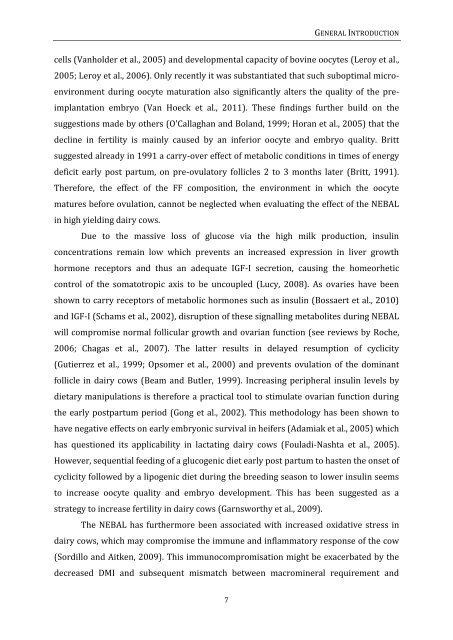view - Department of Reproduction, Obstetrics and Herd Health
view - Department of Reproduction, Obstetrics and Herd Health
view - Department of Reproduction, Obstetrics and Herd Health
Create successful ePaper yourself
Turn your PDF publications into a flip-book with our unique Google optimized e-Paper software.
GENERAL INTRODUCTION<br />
cells (Vanholder et al., 2005) <strong>and</strong> developmental capacity <strong>of</strong> bovine oocytes (Leroy et al.,<br />
2005; Leroy et al., 2006). Only recently it was substantiated that such suboptimal microenvironment<br />
during oocyte maturation also significantly alters the quality <strong>of</strong> the preimplantation<br />
embryo (Van Hoeck et al., 2011). These findings further build on the<br />
suggestions made by others (O'Callaghan <strong>and</strong> Bol<strong>and</strong>, 1999; Horan et al., 2005) that the<br />
decline in fertility is mainly caused by an inferior oocyte <strong>and</strong> embryo quality. Britt<br />
suggested already in 1991 a carry-over effect <strong>of</strong> metabolic conditions in times <strong>of</strong> energy<br />
deficit early post partum, on pre-ovulatory follicles 2 to 3 months later (Britt, 1991).<br />
Therefore, the effect <strong>of</strong> the FF composition, the environment in which the oocyte<br />
matures before ovulation, cannot be neglected when evaluating the effect <strong>of</strong> the NEBAL<br />
in high yielding dairy cows.<br />
Due to the massive loss <strong>of</strong> glucose via the high milk production, insulin<br />
concentrations remain low which prevents an increased expression in liver growth<br />
hormone receptors <strong>and</strong> thus an adequate IGF-I secretion, causing the homeorhetic<br />
control <strong>of</strong> the somatotropic axis to be uncoupled (Lucy, 2008). As ovaries have been<br />
shown to carry receptors <strong>of</strong> metabolic hormones such as insulin (Bossaert et al., 2010)<br />
<strong>and</strong> IGF-I (Schams et al., 2002), disruption <strong>of</strong> these signalling metabolites during NEBAL<br />
will compromise normal follicular growth <strong>and</strong> ovarian function (see re<strong>view</strong>s by Roche,<br />
2006; Chagas et al., 2007). The latter results in delayed resumption <strong>of</strong> cyclicity<br />
(Gutierrez et al., 1999; Opsomer et al., 2000) <strong>and</strong> prevents ovulation <strong>of</strong> the dominant<br />
follicle in dairy cows (Beam <strong>and</strong> Butler, 1999). Increasing peripheral insulin levels by<br />
dietary manipulations is therefore a practical tool to stimulate ovarian function during<br />
the early postpartum period (Gong et al., 2002). This methodology has been shown to<br />
have negative effects on early embryonic survival in heifers (Adamiak et al., 2005) which<br />
has questioned its applicability in lactating dairy cows (Fouladi-Nashta et al., 2005).<br />
However, sequential feeding <strong>of</strong> a glucogenic diet early post partum to hasten the onset <strong>of</strong><br />
cyclicity followed by a lipogenic diet during the breeding season to lower insulin seems<br />
to increase oocyte quality <strong>and</strong> embryo development. This has been suggested as a<br />
strategy to increase fertility in dairy cows (Garnsworthy et al., 2009).<br />
The NEBAL has furthermore been associated with increased oxidative stress in<br />
dairy cows, which may compromise the immune <strong>and</strong> inflammatory response <strong>of</strong> the cow<br />
(Sordillo <strong>and</strong> Aitken, 2009). This immunocompromisation might be exacerbated by the<br />
decreased DMI <strong>and</strong> subsequent mismatch between macromineral requirement <strong>and</strong><br />
7









